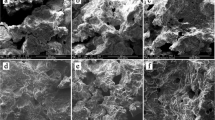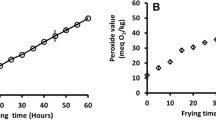Abstract
The purpose of this study was to develop and test the combination of nuclear magnetic resonance (NMR) and magnetic resonance imaging (MRI) method to assess the proton changes of sea cucumber body wall during low-temperature heating process. NMR relaxometry and MRI measurements indicated a significant proton change in the internal structure for sea cucumber body wall when the heating temperature increased from 45 to 55 °C. Differential scanning calorimetry (DSC) analysis revealed that the denaturation temperature of sea cucumber body wall was in the range of 45–55 °C with an endothermic peak at 51 °C, which is in accordance with the result observed in NMR and MRI. Rheological study showed similar trend to the DSC thermogram. The band change in amide I region of Fourier transform infrared (FTIR) spectra indicated the decrease in α-helix content and possible formation of other secondary structures. Scanning electron microscopy (SEM) further confirmed that the low-temperature heating did induce microstructure changes. The analysis of the Ringerʼs soluble fraction (RSF), enzyme-labile fraction (ELF), and total unaltered fraction (TUF) for sea cucumber body wall during low-temperature heating provided more detailed information on the cause of structure change observed in NMR and MRI. The NMR parameters were highly correlated with the rheology storage modulus (G′), relative enzymatic assay parameters, RSF, ELF, and TUF. All these results demonstrated that it could be possible to use NMR and MRI to assess sea cucumber tenderization during low-temperature heating process.







Similar content being viewed by others
References
Bertram HC, Wu Z, Berg FVD, Andersen HJ (2006) NMR relaxometry and differential scanning calorimetry during meat cooking. Meat Sci 74:684–689. doi:10.1016/j.meatsci.2006.05.020
Carneiro CDS, Mársico ET, Ribeiro RDOR, Conte Júnior CA, Álvares TS, De Jesus EFO (2013) Quality attributes in shrimp treated with polyphosphate after thawing and cooking: a study using physicochemical analytical methods and low-field1H NMR. J Food Process Eng 36:492–499. doi:10.1111/jfpe.12011
Cui F-X, Xue C-H, Li Z-J, Zhang Y-Q, Dong P, Fu X-Y, Gao X (2007) Characterization and subunit composition of collagen from the body wall of sea cucumber Stichopus japonicus. Food Chem 100:1120–1125. doi:10.1016/j.foodchem.2005.11.019
Dileep A, Shamasundar B, Binsi P, Badii F, Howell N (2005) Effect of ice storage on the physicochemical and dynamic viscoelastic properties of ribbonfish (Trichiurus spp) meat. J Food Sci 70:E537–E545. doi:10.1111/j.1365-2621.2005.tb08316.x
Geng S, Wang H, Wang X, Ma X, Xiao S, Wang J, Tan M (2015) A non-invasive NMR and MRI method to analyze the rehydration of dried sea cucumber. Anal Methods-UK 7:2413–2419. doi:10.1039/C4AY03007A
Goetz J, Koehler P (2005) Study of the thermal denaturation of selected proteins of whey and egg by low resolution NMR. LWT-Food Sci Technol 38:501–512. doi:10.1016/j.lwt.2004.07.009
Han M, Zhang Y, Fei Y, Xu X, Zhou G (2009) Effect of microbial transglutaminase on NMR relaxometry and microstructure of pork myofibrillar protein gel. Eur Food Res Technol 228:665–670. doi:10.1007/s00217-008-0976-x
Herrero AM, Carmona P, García ML, Solas MT, Careche M (2005) Ultrastructural changes and structure and mobility of myowater in frozen-stored hake (Merluccius merluccius L.) muscle: relationship with functionality and texture. J Agric Food Chem 53:2558–2566. doi:10.1021/jf0490706
Hill F (1966) The solubility of intramuscular collagen in meat animals of various ages. J Food Sci 31:161–166. doi:10.1111/j.1365-2621.1966.tb00472.x
Hong Y-S, Cho J-H, Kim N-R, Lee C, Cheong C, Hong KS, Lee C-H (2009) Artifacts in the measurement of water distribution in soybeans using MR imaging. Food Chem 112:267–272. doi:10.1016/j.foodchem.2008.05.109
Kim S-K, Himaya S (2012) Triterpene glycosides from sea cucumbers and their biological activities. Adv Food Nutr Res 65:297–319. doi:10.1016/B978-0-12-416003-3.00020-2
Kr S (1986) Vibrational spectroscopy and conformation of peptides, polypeptides, and proteins. Adv Protein Chem 38:181–364
Lee DC, Haris PI, Chapman D, Mitchell RC (1990) Determination of protein secondary structure using factor analysis of infrared spectra. Biochemist 29:9185–9193. doi:10.1021/bi00491a012
Leikina E, Mertts M, Kuznetsova N, Leikin S (2002) Type I collagen is thermally unstable at body temperature. P Natl Acad Sci USA 99:1314–1318. doi:10.1073/pnas.032307099
Li C, Liu D, Zhou G, Xu X, Qi J, Shi P, Xia T (2012) Meat quality and cooking attributes of thawed pork with different low field NMR T 21. Meat Sci 92:79–83. doi:10.1016/j.meatsci.2011.11.015
Liu J, Zhu K, Ye T, Wan S, Wang Y, Wang D, Li B, Wang C (2013) Influence of konjac glucomannan on gelling properties and water state in egg white protein gel. Food Res Inter 51:437–443. doi:10.1016/j.foodres.2013.01.002
Liu L, Zhang Z, Liu Q, Yang B, Huang J, Gao X (2012) Rheological and structural properties of sea cucumber Stichopus japonicus during different heating temperature. Int J Fish Aquaculture 4:209–216. doi:10.5897/IJFA12.027
Liu R, Zhao S-M, Xiong S-B, Xie B-J, Qin L-H (2008) Role of secondary structures in the gelation of porcine myosin at different pH values. Meat Sci 80:632–639. doi:10.1016/j.meatsci.2008.02.014
Lomiwes D, Farouk M, Wu G, Young O (2014) The development of meat tenderness is likely to be compartmentalised by ultimate pH. Meat Sci 96:646–651. doi:10.1016/j.meatsci.2013.08.022
Marcone MF, Wang S, Albabish W, Nie S, Somnarain D, Hill A (2013) Diverse food-based applications of nuclear magnetic resonance (NMR) technology. Food Res Inter 51:729–747. doi:10.1016/j.foodres.2012.12.046
Nagai T, Suzuki N (2000) Isolation of collagen from fish waste material - skin, bone and fins. Food Chem 68:277–281. doi:10.1016/S0308-8146(99)00188-0
Naganathan GK, Grimes LM, Subbiah J, Calkins CR, Samal A, Meyer GE (2008) Visible/near-infrared hyperspectral imaging for beef tenderness prediction. Comput Electron Agr 64:225–233. doi:10.1016/j.compag.2008.05.020
Nakano S, Kousaka J, Fujii K, Yorozuya K, Yoshida M, Mouri Y, Akizuki M, Tetsuka R, Ando T, Fukutomi T, Oshima Y, Kimura J, Ishiguchi T, Arai O (2012) Impact of real-time virtual sonography, a coordinated sonography and MRI system that uses an image fusion technique, on the sonographic evaluation of MRI-detected lesions of the breast in second-look sonography. Breast Cancer Res Treat 134:1179–1188. doi:10.1007/s10549-012-2163-9
Patel KK, Khan MA, Kar A (2015) Recent developments in applications of MRI techniques for foods and agricultural produce—an overview. J Food Sci Technol MYS 52:1–26. doi:10.1007/s13197-012-0917-3
Powell T, Hunt M, Dikeman M (2000) Enzymatic assay to determine collagen thermal denaturation and solubilization. Meat Sci 54:307–311. doi:10.1016/S0309-1740(99)00092-3
Rabotyagova OS, Cebe P, Kaplan DL (2008) Collagen structural hierarchy and susceptibility to degradation by ultraviolet radiation. Mat Sci Eng C-Mater 28:1420–1429. doi:10.1016/j.msec.2008.03.012
Sánchez-Valencia J, Sánchez-Alonso I, Martinez I, Careche M (2015) Low-field nuclear magnetic resonance of proton (1H LF NMR) relaxometry for monitoring the time and temperature history of frozen hake (Merluccius merluccius L.) muscle. Food Bioprocess Tech 8:2137–2145. doi:10.1007/s11947-015-1569-x
Saito M, Kunisaki N, Urano N, Kimura S (2002) Collagen as the major edible component of sea cucumber (Stichopus japonicus). J Food Sci 67:1319–1322. doi:10.1111/j.1365-2621.2002.tb10281.x
Salomonsen T, Sejersen MT, Viereck N, Ipsen R, Engelsen SB (2007) Water mobility in acidified milk drinks studied by low-field 1 H NMR. Intl Dairy J 17:294–301. doi:10.1016/j.idairyj.2006.04.003
Sano T, Ohno T, Otsuka-Fuchino H, Matsumoto JJ, Tsuchiya T (1994) Carp natural actomyosin: thermal denaturation mechanism. J Food Sci 59:1002–1008. doi:10.1111/j.1365-2621.1994.tb08177.x
Santos PM, Corrêa CC, Forato LA, Tullio RR, Cruz GM, Colnago LA (2014) A fast and non-destructive method to discriminate beef samples using TD-NMR. Food Control 38:204–208. doi:10.1016/j.foodcont.2013.10.026
Shaarani SM, Nott KP, Hall LD (2006) Combination of NMR and MRI quantitation of moisture and structure changes for convection cooking of fresh chicken meat. Meat Sci 72:398–403. doi:10.1016/j.meatsci.2005.07.017
Shao X, Li Y (2010) Classification and prediction by LF NMR. Food Bioprocess Tech 5:1817–1823. doi:10.1007/s11947-010-0455-9
Susi H, Byler DM (1986) Resolution-enhanced Fourier transform infrared spectroscopy of enzymes. Method Enzymol 130:290–311. doi:10.1016/0076-6879(86)30015-6
Van Laack R, Stevens S, Stalder K (2001) The influence of ultimate pH and intramuscular fat content on pork tenderness and tenderization. J Anim Sci 79:392–397. doi:10.2527/2001.792392x
Yearbook CFS (2009) China fishery statistical yearbook 2008. Fisheries Bureau, Department of Agriculture of China, Beijing (in Chinese)
Yogesh K, Ali J (2014) Effect of mung bean and sprouted mung bean (Vigna radiata) powder on chicken breast meat tenderness, microbial and sensory characteristics. J Food Sci Tech 51:1411–1415. doi:10.1007/s13197-012-0650-y
Zhang L, McCarthy MJ (2012) Black heart characterization and detection in pomegranate using NMR relaxometry and MR imaging. Postharvest Biol Tec 67:96–101. doi:10.1016/j.postharvbio.2011.12.018
Zhang L, McCarthy MJ (2013) NMR study of hydration of navy bean during cooking. LWT-Food Sci Technol 53:402-408. doi:10.1016/j.lwt.2013.03.011
Zhou D-Y, Chang X-N, Bao S-S, Song L, Zhu B-W, Dong X-P, Zong Y, Li D-M, Zhang M-M, Liu Y-X (2014) Purification and partial characterisation of a cathepsin L-like proteinase from sea cucumber (Stichopus japonicus) and its tissue distribution in body wall. Food Chem 158:192–199. doi:10.1016/j.foodchem.2014.02.105
Zhou Y, Yang H, Liu S, Yuan X, Mao Y, Liu Y, Xu X, Zhang F (2006) Feeding and growth on bivalve biodeposits by the deposit feeder Stichopus japonicus Selenka (Echinodermata: Holothuroidea) co-cultured in lantern nets. Aquaculture 256:510–520. doi:10.1016/j.aquaculture.2006.02.005
Zhu J, Wang D, Dong X, Zhu B (2013) Study on tenderization of sea cucumber (StichoPusjaPonicus) by low-temperature heating. In: Abstract of Food Summit in China 2013 & Annual meeting of Chinese Institte of Food Science and Technology (p. 64). Hangzhou China: Chinese Institte of Food Science and Technology
Author information
Authors and Affiliations
Corresponding author
Ethics declarations
Funding
This work was supported by the National Nature Science Foundation of China (31401520, 31401519), the National Key Scientific Instrument and Equipment Development Project of China (2013YQ17046307), the National Key Technology Research and Development Program of China in 12th Five-Year Plan (2014BAD04B09), the Public Science and Technology Research Funds Project of Ocean (201505029), and Cultivation Plan for Youth Agricultural Science and Technology Innovative Talents of Liaoning Province (2015002).
Conflicts of Interest
Xiuping Dong declares that he has no conflict of interest. Yan Li declares that he has no conflict of interest. Yong Li declares that he has no conflict of interest. Liang Song declares that he has no conflict of interest. Shasha Cheng declares that he has no conflict of interest. Dongmei Li declares that he has no conflict of interest. Wei-bei Zhu declares that he has no conflict of interest. Dayong Zhou declares that he has no conflict of interest. Mingqian Tan declares that he has no conflict of interest.
Ethical Approval
This article does not contain any studies with human participants or laboratory animals performed by any of the authors.
Informed Consent
Not applicable.
Rights and permissions
About this article
Cite this article
Dong, X., Li, Y., Li, Y. et al. Combination of NMR and MRI Techniques for Non-invasive Assessment of Sea Cucumber (Stichopus japonicas) Tenderization During Low-Temperature Heating Process. Food Anal. Methods 10, 2207–2216 (2017). https://doi.org/10.1007/s12161-016-0770-5
Received:
Accepted:
Published:
Issue Date:
DOI: https://doi.org/10.1007/s12161-016-0770-5




